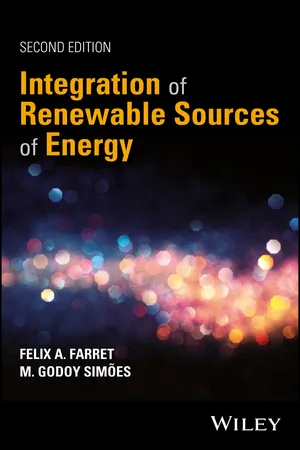
Integration of Renewable Sources of Energy
Felix A. Farret, M. Godoy Simoes
- English
- ePUB (disponibile sull'app)
- Disponibile su iOS e Android
Integration of Renewable Sources of Energy
Felix A. Farret, M. Godoy Simoes
Informazioni sul libro
The latest tools and techniques for addressing the challenges of 21 st century power generation, renewable sources and distribution systems
Renewable energy technologies and systems are advancing by leaps and bounds, and it's only a matter of time before renewables replace fossil fuel and nuclear energy sources. Written for practicing engineers, researchers and students alike, this book discusses state-of-the art mathematical and engineering tools for the modeling, simulation and control of renewable and mixed energy systems and related power electronics. Computational methods for multi-domain modeling of integrated energy systems and the solution of power electronics engineering problems are described in detail.
Chapters follow a consistent format, featuring a brief introduction to the theoretical background, a description of problems to be solved, as well as objectives to be achieved. Multiple block diagrams, electrical circuits, and mathematical analysis and/or computer code are provided throughout. And each chapter concludes with discussions of lessons learned, recommendations for further studies, and suggestions for experimental work.
Key topics covered in detail include:
- Integration of the most usual sources of electrical power and related thermal systems
- Equations for energy systems and power electronics focusing on state-space and power circuit oriented simulations
- MATLAB® and Simulink® models and functions and their interactions with real-world implementations using microprocessors and microcontrollers
- Numerical integration techniques, transfer-function modeling, harmonic analysis, and power quality performance assessment
- MATLAB®/Simulink®, Power Systems Toolbox, and PSIM for the simulation of power electronic circuits, including for renewable energy sources such as wind and solar sources
Written by distinguished experts in the field, Integration of Renewable Sources of Energy, 2nd Edition is a valuable working resource for practicing engineers interested in power electronics, power systems, power quality, and alternative or renewable energy. It is also a valuable text/reference for undergraduate and graduate electrical engineering students.